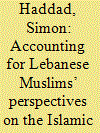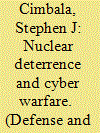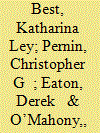|
|
|
Sort Order |
|
|
|
Items / Page
|
|
|
|
|
|
|
| Srl | Item |
| 1 |
ID:
154705


|
|
|
|
|
| Summary/Abstract |
This article seeks to determine the correlates of Lebanese Muslims perceptions of the Islamic State (ISIS) which are measured using the hypotheses that commitment to political Islam, young age, education and occupational status would predict approval of ISIS. In view of the accentuated polarisation between Sunnis and Shiis along sectarian lines, it is proposed that dislike for the Shiis would enhance the level of support for ISIS. The study was based on a cross-sectional survey Lebanese Muslims (N = 302) administered during the fall of 2015.The suggestion is that adherence to the tenets of political Islam, sectarianism and educational attainment are major predictors of endorsement for ISIS.
|
|
|
|
|
|
|
|
|
|
|
|
|
|
|
|
| 2 |
ID:
154702


|
|
|
|
|
| Summary/Abstract |
Nuclear deterrence and cyber war seem almost antithetical in their respective intellectual pedigrees. Nuclear weapons are unique in their ability to create mass destruction in a short time. Information or “cyber” weapons, at least for the most part, aim at sowing confusion or mass disruption instead of widespread physical destruction. Nevertheless, there are some intersections between cyber and nuclear matters, and these have the potential to become troublesome for the future of nuclear deterrence. For example, cyber attacks might complicate the management of a nuclear crisis. As well, information attacks on command-control and communications systems might lead to a mistaken nuclear launch based on false warnings, to erroneous interpretations of data or to panic on account of feared information blackout. It is not inconceivable that future nuclear strike planning will include a preliminary wave of cyber strikes or at least a more protracted “preparation of the battlefield” by roaming through enemy networks to plant malware or map vulnerabilities.
|
|
|
|
|
|
|
|
|
|
|
|
|
|
|
|
| 3 |
ID:
154706


|
|
|
|
|
| Summary/Abstract |
Each age has its own wars and its own forms of warfare. In today’s evolving world risk society warfare has entered a new development stage. The states of the “global North” adapt their forms of intervention. They increasingly practice postmodern warfare characterized especially by the role of influencing the information space, networked approaches, the incorporation of indirect and covert actions, and the special quality of new technologies. This practice furthers an increasing grey zone between limiting and de-bounding of warfare. The phenomenon of postmodern warfare raises some tough questions and offers a rich research agenda.
|
|
|
|
|
|
|
|
|
|
|
|
|
|
|
|
| 4 |
ID:
154707


|
|
|
|
|
| Summary/Abstract |
The existing guidelines for security sector reform (SSR) tend to draw on theoretical work in the field of civil–military relations, which in turn has been derived from Western, liberal democratic models of governance. Although guidelines strongly advise that local culture and context need to be considered when drawing up objectives for post-conflict SSR programmes, this is not often reflected in practice. This article considers some of the reasons for this, citing both in-country challenges and donor-related issues, and suggests that one of the biggest problems is a lack of alternative, non-orthodox models of civil–military relations to draw upon. It is further suggested that elements of suitable alternative models may be found in states which possess political structures not entirely dissimilar to the Western, liberal democratic ideal, but which can offer different perspectives. Detailed research of these structures should produce a pool of sub-models which could then be employed to create bespoke, culturally appropriate objectives for use in post-conflict SSR programmes.
|
|
|
|
|
|
|
|
|
|
|
|
|
|
|
|
| 5 |
ID:
154704


|
|
|
|
|
| Summary/Abstract |
Recent elections in Latin America, such as those of Mauricio Macri in Argentina, Horacio Cartes in Paraguay, and the impeachment process of Dilma Rousseff in Brazil, point to a new direction in Latin American politics and away from the “hard left;” they also point to a new momentum in the security relationship between the US and Latin American countries. Former US President Obama’s 2016 trip to Cuba and Argentina was a clear demonstration of this new security paradigm and also a clear indication that there is a new momentum brewing in the US towards a rethinking and reshaping of security strategies and mindsets. This article will explore the multidimensional security relationship between the US and Latin American countries in light of recent changes in the US’ posture toward the region.
|
|
|
|
|
|
|
|
|
|
|
|
|
|
|
|
| 6 |
ID:
154703


|
|
|
|
|
| Summary/Abstract |
US national security guidance, as well as the US Army’s operational experiences since 2001, emphasizes the importance of working closely with partner countries to achieve US strategic objectives. The US Army has introduced the global landpower network (GLN) concept as a means to integrate, sustain and advance the Army’s considerable ongoing efforts to meet US national security guidance. This study develops the GLN concept further, and addresses three questions. What benefits can the GLN provide the Army? What are the essential components of the GLN? What options exist for implementing the GLN concept? By developing the GLN concept, the Army has the opportunity to transition the GLN from an often ad hoc and reactive set of relationships to one that the Army more self-consciously prioritizes and leverages as a resource to meet US strategic objectives.
|
|
|
|
|
|
|
|
|
|
|
|
|
|
|
|
|
|
|
|
|